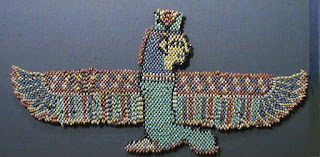Chaussure en cuir bien conservée, avec semelle et empeigne séparées, cousues ensemble, et lanière. Les chaussures en cuir commencent à remplacer les sandales en roseau au quatrième siècle de notre ère. A ce moment, se produit un changement général; les coutumes et productions traditionnelles égyptiennes sont graduellement supplantées par celles de cultures étrangères, principalement asiatique et grecque. Cette chaussure provient de la seule ville fondée, dans le pays, par les Romains, Antinoopolis, en Moyenne Égypte. Elle fut érigée par l'empereur Hadrien sur le site où son amant Antinous se noya en 130 après J.-C. Pendant la Période Byzantine, la ville devint la capitale de la province de Haute Égypte et joua ainsi un rôle important dans l'évolution de la culture matérielle.
EL-CHEIKH `ABADA/ANTINOOPOLIS
PÉRIODE ROMAINE
cuir
flobalegyptianmuseum
NATIONAL MUSEUM OF IRELAND



























